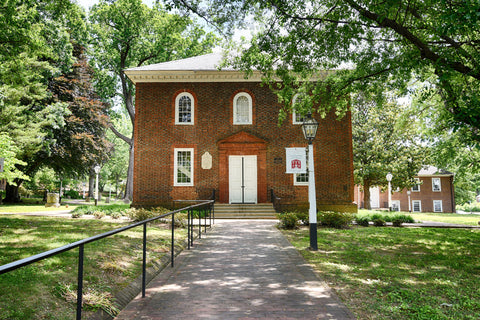
Transformed From a Colonial Town to a Popular D.C. Suburb, Falls Church Holds a Handful of History
A handsome stone church, nestled in the intersection of Fairfax and South Washington streets, embodies the central history of this “little city” in Northern Virginia. Established in the early 1730s as a member of the official Church of England, the then-wood church became known as the one “near the falls” of the Potomac River, and soon thereafter as “The Falls Church,” a name adopted by the community that developed around it and the city itself when it was incorporated in the 20th century. George Washington was an early vestry member and participated in the decision-making that led to the building of the current, Georgian-style stone structure with Palladian windows, completed in 1769.
Located just six miles from Washington, D.C., and settled by many northern colonists, the city’s population was divided in 1861 over secession and many left town when the state of Virginia ultimately voted in favor of it. Confederates occupied the town and the church until silently withdrawing in September 1861 to Centreville, Va. By 1862, the Federals had moved in to occupy the town, the neighboring high grounds at Munson’s and Upton’s Hills, and the church, which was used as a hospital and later a stable.
Confederate Ranger Colonel John S. Mosby reigned terror over the city, conducting raids of it throughout the summer and fall of 1864. In October, his men shot and killed Frank Brooks, a Black member of the highly unusual interracial Falls Church Home Guard, and kidnapped and later killed abolitionist John Read, who is buried in the Falls Church Cemetery. A visit to the church and its cemetery are a must for history enthusiasts on any tour of Falls Church. A half dozen Civil War Trails signs lay mostly within walking distance and will bring you along the city’s journey from sleepy colonial town, through the Civil War, Reconstruction, and to its reemergence as a metropolitan provision for the capital of the United States.
Falls Church Episcopal Church
Cemetery, Falls Church, Va.
Written in Stone
115 E. Fairfax St.
Several memorial stones lay within the Falls Church Episcopal Church Cemetery to commemorate its history, especially during the Civil War. The New York Memorial Stone commemorates New York soldiers buried in the churchyard, including many who died while camped at nearby Upton’s Hill. Some of their remains have been removed to Arlington National Cemetery or family plots. A separate memorial stone in the graveyard commemorates Union soldiers buried here and another commemorates Confederate soldiers buried here, including several unknown. Two poignant markers lay at the head of the walkway leading to the church, including one for James Wren, who designed the church and one “with gratitude and repentance” to honor “the enslaved people whose skills and labor helped build The Falls Church.”
Fort Taylor Park, Falls Church, Va.
Fort Taylor Park
15 N. Roosevelt St.
On June 22, 1861, Thaddeus Lowe and 15 men arrived here, at the site of Taylor’s Tavern, with his balloon Enterprise. Earlier that day, Lowe and his team had inflated it at the Washington Gas Works. Over the next three days, Lowe made several tethered ascents, the first aerial reconnaissance in American military history. Over a 34-day period that summer, Lowe made 23 flights from nearby Fort Corcoran and Ball’s Cross Roads (present-day Ballston). These ascents drew the first rifled artillery fire at a balloon from Confederate positions.
Galloway Methodist Church
Cemetery, Falls Church, Va.
Galloway Methodist Church Cemetery
306 Annandale Rd.
In 1867, African Americans built Galloway United Methodist Church and established the historic cemetery here. According to local tradition, before and during the Civil War, enslaved people on the Dulany plantation secretly worshiped in the grove of trees at the center of the cemetery. Those buried here include Harriet and George Brice and Charles Lee, a free man of color, who served in the 10th USCI. A large grave marker notes the burial site of Eliza Hicks Henderson, who escaped bondage after the Battle of Vicksburg in 1863, and walked from Vicksburg to Washington, D.C., to rejoin her family. She concealed her young son, William Henderson, in a trunk.
Cherry Hill Farmhouse, Falls Church, Va.
Cherry Hill Farmhouse 312 Park Ave.
Although soldiers repeatedly overran and raided Cherry Hill Farm during the Civil War, this circa 1845 farmhouse and the 1856 barn behind it survived almost intact. William Blaisdell of Massachusetts paid $4,000 for the 66-acre property in 1856. The migration of Northerners to this area resulted in a populace of mixed loyalties on the eve of the Civil War. Blaisdell and 25 others in the Falls Church District voted against secession in the statewide referendum held on May 23, 1861, while 44 voted in favor. The Blaisdells, like most families in town, felt the effects of both Confederate and Union occupation. Cherry Hill offers free tours of the farmhouse Saturday mornings, April through October, from 10 a.m. to 12 p.m. Private tours can also be scheduled year round. cherryhillfallschurch.org
Northside Social, Falls Church, Va.
Northside Social
205 Park Ave.
The original house here, “Cloverdale” has late–18th century roots and once faced the Leesburg & Alexandria Turnpike. It saw its fair share of marauding armies during the Civil War, and by the 20th century the building was home to the American Legion Post 225. After years of neglect, instead of demolition, the structure was adaptively reused into the restaurant and cafe it is today. If you are lucky you can catch one of their afternoon tea events. www.northsidesocialva.com/location/falls- church
